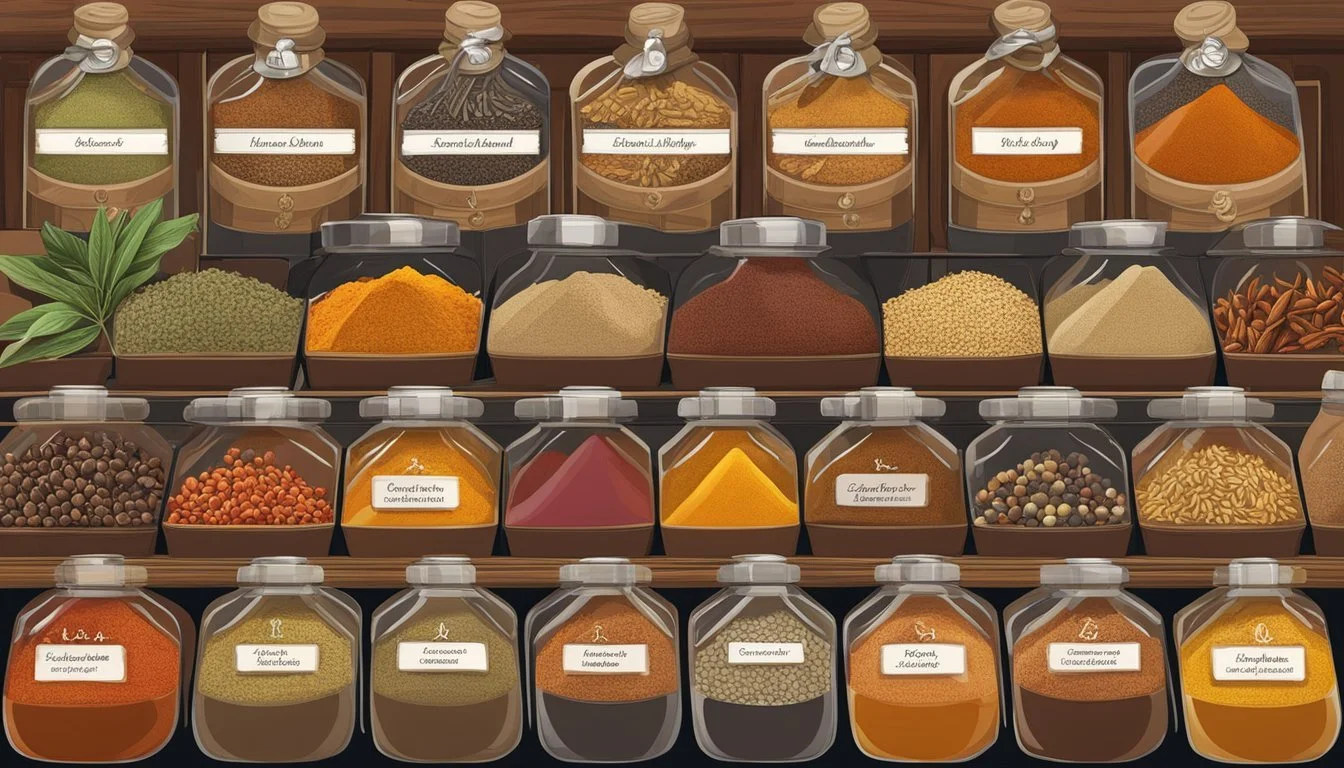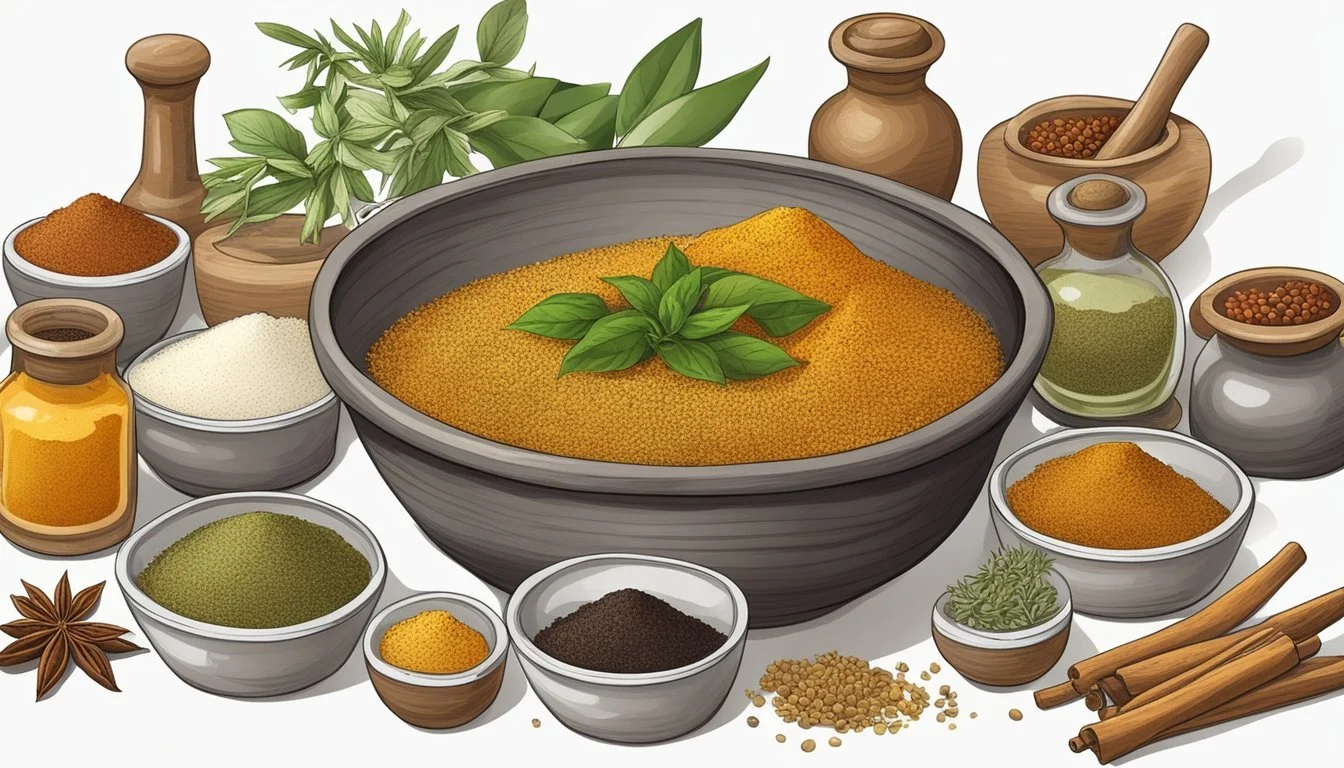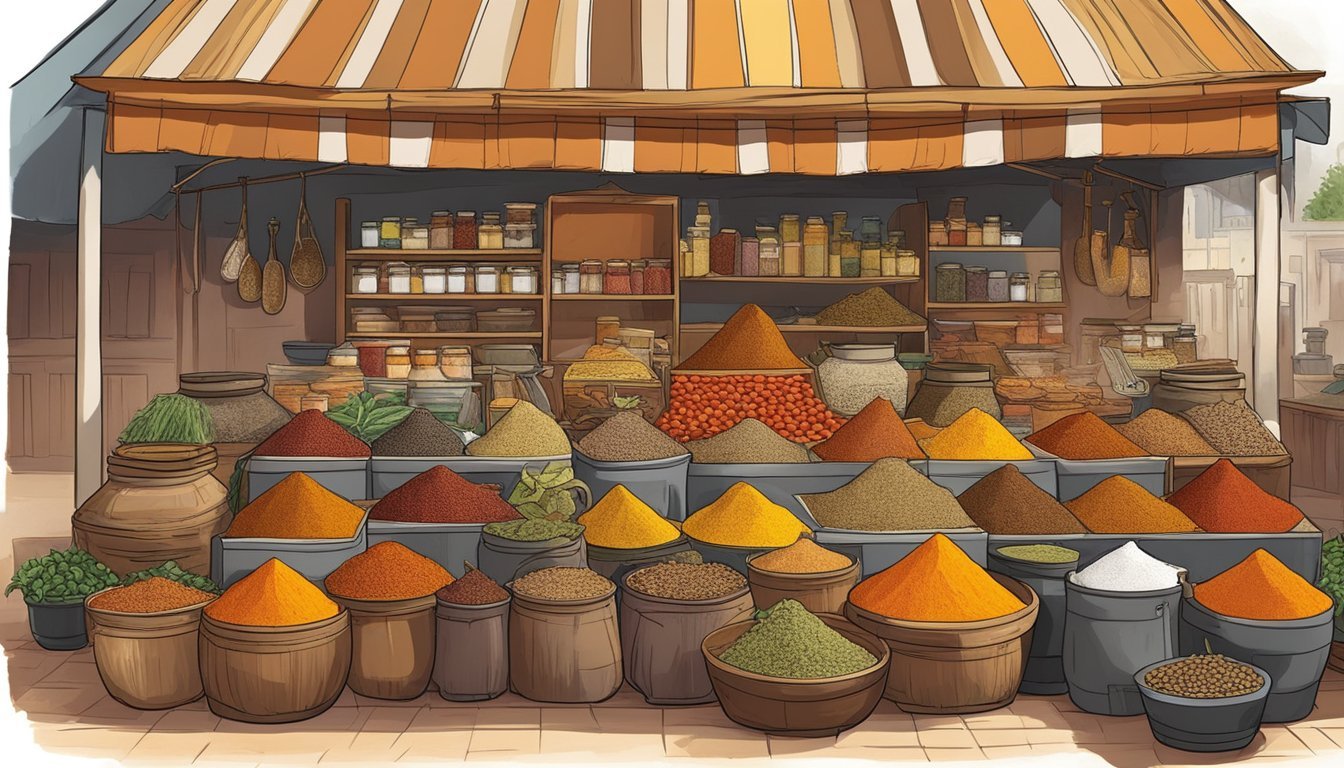Ras el Hanout Substitutes
Best Alternatives for Authentic Flavor
Ras el hanout is a versatile Moroccan spice blend known for its rich and complex flavor profile. Often containing a mix of up to 100 different spices, it can vary greatly from one vendor to another. This variability makes finding a suitable substitute somewhat challenging.
For those unable to source ras el hanout, blending your own mix with commonly used spices like cumin, coriander, ginger, and cinnamon can be a practical alternative. By doing this, home cooks can capture some of the signature warmth and depth of North African cuisine. Beyond these basics, adding less common ingredients such as cardamom or cayenne pepper can elevate the mixture further.
When the specific recipe calls for ras el hanout, achieving that authentic flavor might seem daunting without access to the exact components. Yet, through creative substitutions and a bit of experimentation, it’s possible to approximate the distinctive taste that makes this spice blend so beloved. This blog will guide you through several options to recreate or replace ras el hanout, ensuring your dishes maintain their unique and flavorful essence.
Understanding Ras El Hanout
Ras el hanout is a traditional spice blend hailing from North Africa, particularly prevalent in Moroccan cuisine. This aromatic mix is a hallmark of North African culinary traditions.
The spice blend is known for its complexity and rich flavor profile. It typically contains a medley of spices like cumin, coriander, cinnamon, cloves, cardamom, and ginger. Occasionally, unique ingredients such as lavender and rose petals are also added, giving it a distinctive aroma.
Common Spices in Ras El Hanout
Cumin
Coriander
Cinnamon
Cloves
Cardamom
Ginger
Lavender
Rose Petals
This blend is not just a single recipe but can vary widely depending on the maker's preference. This variability adds to its depth and versatility in the kitchen.
It is commonly used to season meat, vegetables, and rice dishes, lending an aromatic and complex depth to these North African dishes. The versatility of this blend makes it a beloved staple in both traditional and modern Moroccan cooking.
Ras el hanout's unique blend of spices allows it to impart a warm, aromatic, and slightly sweet flavor that enhances the overall taste of various dishes, making it an essential component in Moroccan cuisine.
The Role of Individual Spices in Ras El Hanout
Ras el Hanout is a complex spice blend integral to North African cuisine. Its flavor profile ranges from sweet and aromatic to earthy and spicy, courtesy of a diverse mix of individual spices.
Core Spices
Cumin adds a warm, earthy base that anchors the blend. It brings a distinct pungency and depth that complements richer dishes.
Coriander contributes a light, citrusy flavor, enhancing the aromatic quality of Ras el Hanout. Its slight sweetness balances out the more potent spices.
Cinnamon introduces sweet and woody notes. This spice provides both aroma and a subtle sweetness, essential for the blend's complexity.
Black Pepper infuses a sharp, biting heat. It intensifies the overall spiciness and enhances other flavors.
Turmeric gives a mild peppery-ginger flavor and a vibrant yellow color. It brings an earthy undertone that enriches the blend's base.
Ginger offers a mild spiciness with a slightly sweet aftertaste. It adds warmth and a fresh zing.
Paprika imparts a sweet, peppery warmth and a rich red color. It balances the blend's flavor and adds a touch of sweetness.
Additional Flavor Enhancers
Nutmeg introduces a sweet and nutty character, enhancing both aroma and complexity. It's used sparingly for layers of subtle flavor.
Cardamom brings a floral and citrusy note, providing a refreshing balance to the blend.
Saffron contributes a unique, luxurious flavor with earthy and sweet notes. Its vibrant color also brightens dishes.
Cloves offer an intense, aromatic warmth. Their strong flavor can dominate, so they are used in moderation.
Allspice combines flavors of cinnamon, nutmeg, and cloves. This makes it an effective ingredient for adding depth.
Cayenne provides a fiery kick. It's used to control the blend's heat level.
Mace adds a delicate nutty and sweet flavor, similar to nutmeg but softer.
Rose Petals and Lavender bring floral notes, increasing the aromatic qualities and adding a subtle, sweet undertone. These ingredients elevate the overall sensory experience.
Finding a Substitute for Ras El Hanout
Ras el hanout is a complex Moroccan spice blend that adds depth and warmth to dishes. When it’s unavailable, several alternatives can stand in to replicate its unique flavor profile effectively.
Common Substitutes and Alternatives
Garam Masala is often recommended as a substitute due to its similar blend of spices like cumin, coriander, and cloves. It shares many of the same components, making it a versatile alternative. To mimic ras el hanout's heat, add a small amount of cayenne pepper.
Curry Powder is another accessible option. It contains cumin, coriander, and turmeric, bringing warmth and color to dishes. It lacks some of the floral notes of ras el hanout, so consider adding a small quantity of allspice or clove.
Baharat is a Middle Eastern spice mix that can also work as a substitute. It contains many of the same spices, including coriander, cinnamon, and cloves. This blend has a slightly different flavor profile but still complements many dishes.
Allspice on its own can serve as a part of the spice substitution mix. Though it lacks complexity, using it in conjunction with other spices can help achieve a closer taste. Start with around half the required amount and adjust as needed.
Homemade Ras El Hanout Blend
Creating a homemade ras el hanout blend allows control over the flavor profile and ratios. Begin with common spices found in most kitchens.
Ingredients:
1 tsp ground cumin
1 tsp ground coriander
1/2 tsp ground ginger
1/2 tsp ground cinnamon
1/4 tsp ground cloves
1/4 tsp ground nutmeg
1/4 tsp ground black pepper
1/4 tsp ground turmeric
1/8 tsp ground cayenne pepper
Instructions: Mix all the ground spices in a small bowl until well combined. Adjust the quantities to taste and to better match the specific flavor of ras el hanout.
This blend can be stored in an airtight container for future use. By adjusting proportions, one can replicate the complexity of the traditional Moroccan spice blend more closely.
Application of Ras El Hanout Substitutes in Cooking
Ras el hanout adds a distinctive blend of flavors, but suitable substitutes can replicate its sweet, earthy, and warm notes and adapt to various savory dishes effectively.
Meats and Poultry
Using substitutes like garam masala or curry powder can transform meats and poultry. Garam masala, with cumin, coriander, and cinnamon, offers warmth and an earthy, sweet undertone. It's ideal for grilled meats or roasted poultry, adding depth without overpowering the natural flavors. A mix of cumin, coriander, paprika, and cinnamon can also be used to marinate meat, enhancing Moroccan tagine recipes with its smoky and slightly spicy kick.
When preparing a hearty stew or slow-cooked dish, these substitutes infuse the dish with complex spices. For added heat, a pinch of cayenne can be included. Each substitute enriches the dish, creating layers of taste that complement the moist, tender texture of slow-cooked meats.
Rice and Stew Preparations
In rice dishes, such as couscous or pilafs, curry powder or a customized spice blend underscores the dish with an aromatic and vibrant profile. The turmeric in curry powder can give these dishes a bright yellow color, enhancing their visual appeal and warmth.
For stews, substituting ras el hanout with garam masala brings a rich, savory flavor, ideal for hearty vegetable or meat-based preparations. It accentuates the sweet and earthy ingredients, making it a staple for soups and stews that require a complex taste. Additionally, these substitutes can be used in Moroccan tagines, providing a full-bodied, satisfying flavor that mirrors the traditional spice mix.
By adapting these substitutes, one can efficiently recreate the depth and complexity of ras el hanout in various savory dishes, ensuring a flavorful cooking experience.
Maintaining True Moroccan Flavors
Preserving the authentic taste of Moroccan cuisine involves careful selection of high-quality spices and proper storage methods. Paying attention to these details ensures that your dishes remain true to the rich culinary traditions of North Africa.
Selecting Quality Spices
Choosing the right spices involves more than just picking what’s available. Whole spices are often preferred over ground spices for their intense flavors and longer shelf life. In Moroccan cuisine, individual spices like cumin, coriander, and cinnamon play a crucial role. For an authentic touch, look for whole Kashmiri saffron stigma, known for its distinct coloring and flavor. Avoid pre-mixed spice blends unless they come from reputable sources that guarantee freshness and quality.
Careful inspection of spices before purchase is advisable. Organic labels and certifications often indicate higher quality. Smell the spices; they should have a strong, fresh aroma. Spices with faded colors or weak scents may have lost their potency and should be avoided.
Preservation and Storage Advice
Proper storage is essential to maintain the flavors. Spices should be kept in a cool, dark place, away from direct sunlight and heat sources to prevent them from becoming stale. Use airtight containers to protect against moisture and air exposure. Glass jars with tight-fitting lids or vacuum-sealed bags are excellent choices.
Label each container with the name and purchase date of the spice. This practice helps in tracking freshness. Whole spices generally last longer than ground varieties, up to two years, while ground spices might need to be replaced every six months. Refrain from storing spices in the refrigerator, as the humidity can degrade their quality.
Regularly inspect your spice inventory. Rotate out older spices and make sure nothing goes to waste by using the oldest first. This practice ensures your spices remain fresh and flavorful, thus maintaining the authenticity of your Moroccan dishes.
Cultural Significance of Ras El Hanout in North African Cuisine
Ras el Hanout, a cornerstone of North African cuisine, often symbolizes the rich cultural heritage of regions such as Morocco, Tunisia, and Algeria. This spice blend, translating to "head of the shop" or "top shelf" in Arabic, embodies the essence of premium, high-quality spices.
In Moroccan cuisine, it plays a pivotal role in traditional dishes like tagines and couscous. Its aromatic profile enhances the depth and complexity of flavors, reflecting the culinary traditions passed down through generations.
Cultural traditions around Ras el Hanout emphasize its creation as an art form. Spice merchants craft unique blends tailored to their offerings, making each mix distinct. This personalization is a testament to the culinary artistry present in African cuisine.
Ras el Hanout’s extensive use signifies its importance. It’s not just a spice but a heritage component, illustrating the region’s history and the culinary ingenuity of its people. The blend’s ingredients, often including cumin, ginger, cinnamon, and cardamom, reflect the diverse influences and rich trading history of North Africa.
In summary, Ras el Hanout serves as a flavorful representation of North African traditions, highlighting the region’s commitment to culinary excellence and cultural preservation.
Creating Fusion Dishes with Ras El Hanout Substitutes
Exploring Ras El Hanout substitutes opens the door to exciting culinary fusion. Utilize these alternatives to blend Middle Eastern, Asian, and Western flavors seamlessly for a range of savory, sweet, and spicy dishes.
Incorporating Middle Eastern Influences
Middle Eastern spices like za’atar, baharat, and harissa can elevate fusion dishes. Use za'atar to season roasted vegetables or flatbreads for a fragrant, herbaceous touch. Replace Ras El Hanout with baharat in soups or stews for a warm, earthy flavor profile. Harissa can introduce a spicy kick to marinades or sauces, adding complexity and heat. Each substitute can seamlessly integrate with Middle Eastern ingredients such as garlic, chili powder, and tahini, creating rich, sophisticated flavors.
Experimenting with Asian Spices
Asian spice blends such as Chinese five-spice powder and garam masala can offer unique twists in fusion dishes. Chinese five-spice powder, with its blend of cinnamon, cloves, fennel, star anise, and Szechuan peppercorns, imparts a sweet-savory complexity perfect for stir-fries or marinades. Garam masala, containing cumin, coriander, and fenugreek among other spices, offers robust warmth to curries and grilled meats. Experimenting with these substitutes can bring unexpected depth and a blend of aromatics to traditional recipes.
Adapting Ras El Hanout for Western Cuisines
Western dishes can benefit from the rich flavors of Ras El Hanout substitutes like curry powder and cajun seasoning. Curry powder, a mix including turmeric, coriander, and cumin, can enhance soups, stews, or even potato salads with its warm, spicy notes. Cajun seasoning, which often contains paprika, garlic, and oregano, offers a bold, spicy kick ideal for jazzing up grilled chicken or shrimp. This flavor adaptation bridges traditional Western tastes with the exotic intensity of North African spices, allowing for creative and flavorful dishes.






